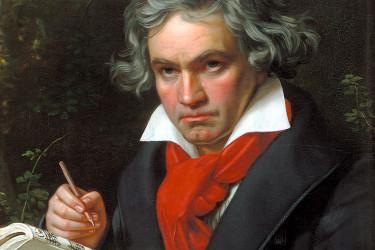Whether it’s the NBA, the now-obsolete Nintendo Wii, or the European Union, Beethoven’s Ninth Symphony—especially the triumphant “Ode to Joy” of the final movement—has been used just about everywhere. First performed in 1824, Beethoven’s Ninth Symphony shattered the mold of the very definition of a symphony by incorporating voices in the final movement, which takes its text from Friedrich Schiller’s poem “Ode to Joy.” The poetry speaks of humankind becoming brothers and rejoicing in its newfound unity, a radical sentiment at a time when democratic revolts were sweeping Europe. The Ninth Symphony was initially controversial but has since been accepted as one of the great masterpieces of Western Art Music.
In the nearly 200 years since its premiere, the Ninth Symphony has been used across pop culture in a myriad of ways—as a common cultural touchstone, embedded in film soundtracks and advertisements, and even as a popular piece to mark the end of the year.
NBA Ads
In the 1990s, the NBA used Beethoven’s “Ode to Joy” in their “I Love this Game” campaign, using the piece to score the complex emotions of the sport—excitement, anguish, joy.
But this isn’t the only time Beethoven’s music has served as the soundtrack on the court. Even King James himself recently said that he listens to Beethoven to calm down between pumping iron in the weight room and getting hyped up for a game. (Note: contains some adult language)
Anthem of the European Union
“Ode to Joy” has been the official anthem of the European Union since 1985. According to the European Union, the anthem is meant to symbolize the “European ideals of freedom, peace, and solidarity.” None of the original German words are used in the anthem—only the melody—so that the listener can experience the “universal language of music.”
Nintendo Wii
Wii Music, a video game developed for Nintendo Wii, was released in 2008. Players would choose from a several musical instruments and mimic the action of playing with the Wii controller. Instead of getting points for their accuracy, players were encouraged to improvise and come up with their own ways to play songs. Among the 50 songs that came with the game were eight classical pieces, including Beethoven’s “Ode to Joy.” Other classical pieces included Mozart’s Eine Kleine Nachtmusik (#53 on the 2023 Ultimate Playlist) and Strauss’s The Blue Danube (#123). Perhaps not surprisingly, Wii Music was one of the worst sellers in the product’s history, selling just 2.65 million copies worldwide as of March 2009.
A Muppets Parody
Who doesn’t love a good Muppets parody? In this clip, Muppet mad scientist Beaker plays all the parts of the “Ode to Joy” himself, taking the task so seriously that he is literally on fire. It’s charming, witty, cute—everything we love about the Muppets.
The Villains’ Theme in Die Hard
Beethoven’s Ninth Symphony is everywhere in 1988’s Die Hard, in which a group of terrorists plot to break into Nakatomi Plaza during a party on Christmas Eve. The ominous bass and cello opening of the finale is the first snippet of the Ninth Symphony we hear in Die Hard, when the villains are first introduced. When the villains manage to open the bank vault, the “Ode to Joy” emerges in full orchestra (plus the addition of an organ!) as computer hacker Theo exclaims “Merry Christmas!”
Popular End-of-Year Tradition
Beethoven’s Ninth Symphony is a popular end-of-year piece at symphonies around the world. The Seattle Symphony has played it every New Year’s Eve since 1999. But the tradition of playing the Ninth Symphony at the end of the year actually began in an unlikely place—Japan.
The Germans had maintained a military presence in East Asia since the late 1890s and brought plenty of classical scores with them, including lots of Beethoven. In 1914, Japan captured Tsingtao, a city on the eastern shore of China that was then the site of a major German military base. When the Germans refused to surrender, Japan took nearly 4,000 soldiers as prisoners of war. About a thousand were sent to Bando, a camp in Naruto, in Tokushima Prefecture, located far inland.
The detained soldiers maintained a camp newspaper and formed multiple orchestras and music ensembles. Some POWs, such as soldier and violinist Paul Engel, were even allowed special dispensation to leave the camp and give music lessons to the local community. Music and sport were the primary ways the Japanese and Germans learned about each other’s cultures.

An orchestra of German POWs at Bando Camp – Tokashima Prefectural Board of Education
Over one hundred concerts took place during the almost three years that POWs were detained at Bando. On December 10 1916, the POWs had a concert that included the Peer Gynt suite and Beethoven’s second piano concerto. Some eighty musicians spent months rehearsing the Ninth Symphony, and it was finally performed on June 1, 1918 in Barrack 1 of Bando Camp—the premiere of the work in Japan. The German soldiers were released on December 30, 1919.
To this day, Beethoven’s Ninth Symphony continues to be performed in Japan as a symbol of cultural exchange, community-building, and an end-of-year tradition. Singalongs are especially popular. The most famous is the Suntory 10,000 Freude concert at Osaka’s Suntory Hall, which boasts 10,000 amateur and professional singers.
10,000 amateur and professional singers take part in a singalong version of “Ode to Joy” in Osaka.







